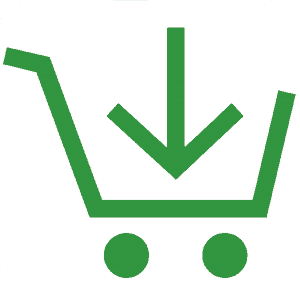The concepts of a buying audience and customer intent are simple and not particularly difficult to understand or apply to your business. However, if you don’t keep these in mind when selecting your niche, it can be detrimental to your success.
Lesson 8 will discuss what a buying audience is, why it’s important, and provide examples of how to predict customer intent to make sure you have a buying audience.
What Exactly is a Buying Audience?
Once you’ve narrowed down a niche, the next question to ask yourself is: will the people who visit my website and read my articles make a purchase to solve their pain points or answer their questions?

I can’t emphasize enough how important it is to keep this in mind any time you select a niche. Remember when I discussed traffic in the previous lessons, and how it’s the lifeblood of your business? Well, traffic will only make you money when you have a buying audience.
Beware of Freeloaders
This may come off a little harsh, but freeloaders suck. When dealing with a freeloading audience, the number of visitors to your site will steadily go up, and your income will steadily flatline.

The unfortunate reality of Internet Marketing is that there are several niches where people almost never make a purchase based on a website’s content because they’re looking for free information.
A couple of examples of these niches are:
- Song Lyric Websites
- Daily Quote Websites
Both of these sites are niches where the audience is looking to gorge on free information and leave.
Think about it from your own perspective: when you search for song lyrics, are you actually going to buy the music sheet?
The only way to consistently monetize these sites is to add advertisements on them. The problem with doing that is a site that monetizes through ads requires massive traffic for it to be truly profitable. To review this concept, refer back to Lessons 1–2.
To avoid this trap, create content based on search terms people use when trying to solve a pain point or answer a question that will ultimately result in a purchase.
How To Anticipate Customer Intent
Example #1: Private Problems
You’ve done it. I’ve done it. We’ve all searched for solutions to some very personal problems. When people search for terms such as “Athlete’s Foot” or “Ringworm,” they’re probably looking to solve a problem or ease a pain point, which means they’re more likely to make a purchase (possibly more).

The more private the problem, the better. It’s not likely people will discuss private problems with friends or family, or post about them on social media. Most people even avoid seeking medical help. People search online long before they do any of those things for private problems.
Example #2: Emotionally Charged Problems
People who are dealing with relationship woes, pets being in pain, or who are facing something complex and difficult will search online for answers. These people are also likely to make purchases to solve their problems.
Example #3: Product Related Searches
People searching for terms related to a product are probably going to make a purchase or do research first before making a purchase.
The terms people use to search for information evolve the closer they are to buying. Initially, they may use the term “Best ___,” (“Best Vacuums” or “Best Protein Shake”) and use the term “___ versus ___” (“Bagless versus Bagged Vacuum Cleaners”) further along their research for head to head comparisons. A bit further along the buying stage, people may start using the term “[Brand] [Model Number] Reviews” to see reviews for a specific model.
Try to aim for high-priced products. People looking to buy a high-priced product tend to research a lot before they actually purchase the item. The more helpful your content is, the greater the chance they’ll buy through you.

Don’t Just Aim for The Final Solution
Getting a buyer in your audience to the last step of the buying process doesn’t mean you only have to write about the final solution. There are plenty of opportunities in between where they are and the final solution where you could produce content to monetize. Don’t ignore these opportunities because you’re focused on the final solution.
For example, if someone is looking to renovate a house, a way to monetize your site is by selling contractor services. However, there are other ways to monetize your site, such as writing about tools and ingenious renovation hacks. You may be able to walk your audience through a do-it-yourself solution that would mitigate and completely solve their problem.

Guides are also a great way to monetize a site. Continuing with the example of home renovation, you could write a guide to different types of kitchen cabinets or the best kitchen appliances. There is a lot of content to create along the way that will entice your audience to make a purchase decision.
I encourage you to create as much content as possible around your niche to establish yourself as an authority. The more articles you publish, the higher your chances are of getting high rankings.
Review-Based Websites: Who Should Pursue Them?
Review-based sites can be considerably profitable because the individual searching for reviews is typically in the late stages of the research process and more likely to purchase.
However, unless you can buy the products yourself and experience them first-hand, it’s going to be difficult to find a way to add more value than your competition when you only produce articles from second-hand information.
If you can afford to buy the products, or if you can come up with a clever way to get your hands on them without purchasing them, you’ll have a huge advantage. This is especially true in the technology industry where there’s a high barrier of entry. Not a lot of people can afford these gadgets, and if you can provide first-hand insight into using these gadgets, then that’s worth something to your audience.

Remember that success depends greatly on how much value is offered. If you can’t get products and provide a thorough review from using them rather than obtaining the information elsewhere, it’s going to be difficult to add value.
Getting into a High-Priced Product Niche When You Can’t Afford It
High-priced product niches are often lucrative, and review-based sites are great for monetizing them. But what can you do if you can’t afford to buy the products?
One path into a high-priced product niche is to identify the pain points and questions surrounding a product. Call your audience’s attention to the most important things as they’re going through the buying process by answering questions like, “What features should one be looking for? What features are nice to have, but not necessary? How do you know if a product is counterfeit?”
Instead of doing side-by-side cellphone reviews, discuss the features within certain cellphones and what to look out for. Write an article about phone usability in general: what makes a phone usable, which cellphones are the easiest to use, etc.
Here’s another example: instead of doing reviews or comparisons of computers, explain things like RAM, processors, the difference between AMD and Intel Processors, which one is superior to the other, different types of monitors, and so on.

People in the market for computers search for this information and find it on multiple websites instead of going to a single resource that has it all. Position yourself as a credible authority and earn money through affiliate links without having to buy computers to review.